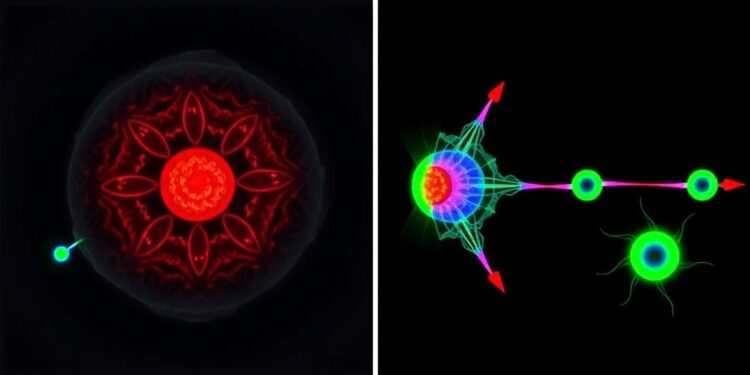
In a groundbreaking study published in the prestigious journal Acta Materia Medica, researchers have introduced an innovative approach to combat cancer through the use of advanced nanomedicines that exhibit multimodal therapeutic capabilities. The complexities of cancer treatment have long posed significant challenges to clinicians, given the heterogeneous nature of tumors and their unique microenvironments. However, this new nanoplatform strategy leverages the power of supramolecular photosensitizers in tandem with chelated metal ions to enhance therapeutic outcomes significantly.
This research focuses on a specific type of nanoparticle, known as ETSCe6 NPs, which serve as photosensitizers and offer several modes of action against tumors. The introduction of these nanoparticles enables a dynamic shift in how tumors respond to treatment, effectively transitioning from photothermal therapy to photodynamic therapy when triggered by specific stimuli in the tumor microenvironment. This dual capability not only provides therapeutic benefits but also aids in tumor visualization, which is critical for accurate diagnosis and treatment planning.
The mechanisms by which these nanoparticles operate are remarkable. Upon introduction into the tumor, the supramolecular photosensitizers undergo self-assembly, which amplifies photothermal therapy efficacy. This enhancement is achieved through a phenomenon known as aggregation-caused quenching, where the nanoparticles’ assembly increases their thermal energy absorption, thereby generating localized heat that can destroy cancer cells. This unique feature of ETSCe6 NPs allows for a more targeted application of therapy, minimizing damage to surrounding healthy tissues.
Glutathione, an important antioxidant that is often found in elevated levels within the tumor microenvironment, plays a critical role in activating the therapeutics delivered by these nanoparticles. The study indicates that glutathione triggers the cleavage of disulfide bonds within the nanoparticles, leading to the release of potent therapeutic agents such as Ergosterol (ET) and Chlorin e6. This selective release mechanism ensures that cytotoxic agents are delivered directly to cancer cells, maximizing therapeutic efficacy while reducing systemic side effects.
Furthermore, the study elucidates the incorporation of chelated high-valence metal ions such as gold (Au) and bismuth (Bi) within the nanoparticle framework. These metal ions not only improve the imaging capabilities through computed tomography but also complement the therapeutic actions of the photosensitizers. The dual functionality of these nanoparticles underscores a critical advancement in nanomedicine, providing real-time imaging alongside effective treatment modalities.
The in vitro and in vivo results reported in this study demonstrate the remarkable efficacy of ETSCe6@Au, Bi NPs. In laboratory settings, these nanoparticles succeeded in not only inhibiting tumor growth but achieving complete tumor elimination in tested animal models following treatment. Such outstanding results showcase the potential for translating these findings into clinical applications, as researchers continue to explore the benefits of combining imaging and therapy within a single nanoplatform.
This integrated approach marks a significant step forward in the development of intelligent nanomedicines. It proposes a new paradigm in cancer treatment, where detection and intervention are seamlessly combined to provide a comprehensive therapeutic strategy. The implications of this research reach far beyond mere improvements in treatment methodologies; they open doors to more personalized and effective cancer care, aligning with contemporary trends in precision medicine.
With the publication of these findings, Acta Materia Medica extends an invitation to scholars around the globe to contribute their research, reviews, and insights to advance the field of materia medica and nanomedicine. The journal is committed to sharing knowledge that bridges the gap between scientific research and clinical practice, promoting innovative solutions for complex health challenges.
Researchers and clinicians interested in submitting their work to Acta Materia Medica can utilize the ScholarOne platform for a streamlined review and publication process. Importantly, the journal stresses the accessibility of research by having no author submission or article processing fees, encouraging widespread participation from the scientific community.
This study signifies a forward leap into the future of cancer treatment, reinforcing the belief that innovative strategies involving nanotechnology and supramolecular chemistry could revolutionize the way we look at cancer therapies. By embracing such pioneering approaches, the medical community can move closer to overcoming the formidable challenges posed by cancer.
As we witness these advancements unfold, it is crucial for researchers, clinicians, and the public to stay informed about the evolving landscape of cancer treatment. Scientific publications, like those found in Acta Materia Medica, play a vital role in disseminating knowledge and catalyzing discussions that could lead to groundbreaking discoveries and improved patient outcomes. It is through collective efforts that the scientific community can continue to innovate and inspire hope in the ongoing battle against cancer.
This noteworthy research exemplifies the intersection of science, technology, and healthcare. By harnessing the power of nanomedicine, we are not only tackling the immediate issues associated with cancer treatment but are also laying the foundation for future advancements that may one day lead to curative therapies that are both effective and compassionate.
Subject of Research: Nanomedicine and cancer treatment
Article Title: Natural supramolecular photosensitizer with in situ switchable photothermal/photodynamic effects as an imaging platform for precise and controlled cancer synergistic therapy
News Publication Date: 2025
Web References: [not provided]
References: [not provided]
Image Credits: [not provided]
Keywords: Nanomedicine, cancer therapy, photothermal therapy, photodynamic therapy, supramolecular photosensitizers, tumor microenvironment, intelligent nanomedicines.
Tags: adaptive nanomedicineadvanced nanoparticle designaggregation-caused quenching in cancer therapycancer imaging techniquesETSCe6 nanoparticlesmultimodal cancer therapyphotothermal and photodynamic therapyself-assembly mechanisms in therapysupramolecular photosensitizerssynergistic therapeutic approachestargeted cancer treatmenttumor microenvironment interactions





